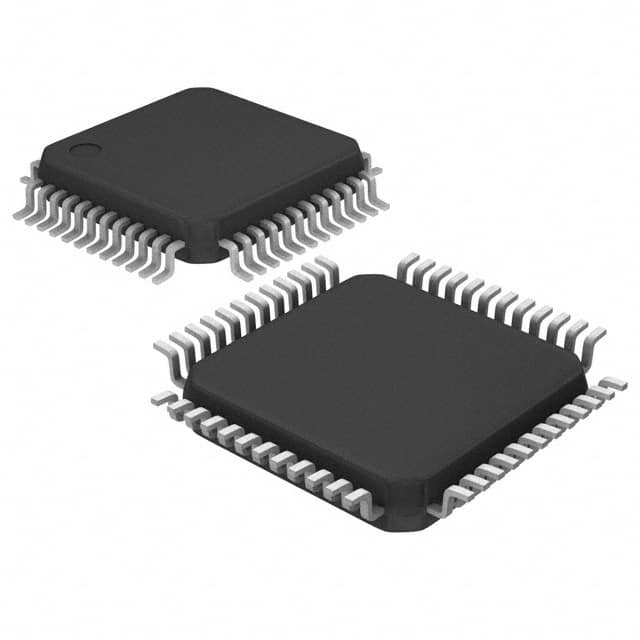Lihat spesifikasi untuk detail produk.

W5500
Product Overview
- Category: Integrated Circuit (IC)
- Use: Ethernet Controller
- Characteristics: High-performance, low-power, TCP/IP embedded Ethernet controller
- Package: 48-pin QFN (Quad Flat No-Lead) package
- Essence: Provides a network interface for devices to connect to an Ethernet network
- Packaging/Quantity: Available in reels of 2500 units
Specifications
- Interface: SPI (Serial Peripheral Interface)
- Ethernet Standard: IEEE 802.3 10/100Mbps
- Operating Voltage: 3.3V
- Operating Temperature: -40°C to +85°C
- Memory: 32KB internal buffer memory
- Supported Protocols: TCP, UDP, ICMP, IPv4, ARP, IGMP, PPPoE
- Supported Features: Full-duplex and half-duplex modes, Auto-negotiation, Wake-on-LAN, Power-down mode
Detailed Pin Configuration
The W5500 has a total of 48 pins. Here are some of the important pins:
- VCC: Power supply voltage input
- GND: Ground reference
- SCSn: Chip select input for SPI communication
- SCLK: Serial clock input for SPI communication
- MOSI: Master output, slave input for SPI communication
- MISO: Master input, slave output for SPI communication
- RSTn: Reset input
- INTn: Interrupt output
For a complete pin configuration, please refer to the datasheet.
Functional Features
- High Performance: Supports up to 80MHz SPI clock speed for fast data transfer.
- Low Power Consumption: Optimized power management features for energy-efficient operation.
- Embedded TCP/IP Stack: Integrated TCP/IP stack for easy network communication.
- Hardware TCP/IP Offload: Offloads TCP/IP processing from the host microcontroller, reducing the workload.
- Flexible Network Configuration: Supports various network configurations such as static IP, DHCP, and PPPoE.
Advantages and Disadvantages
Advantages: - High-performance Ethernet controller - Low power consumption - Easy integration with embedded systems - Flexible network configuration options
Disadvantages: - Limited to SPI interface for communication - Requires external components for complete network connectivity
Working Principles
The W5500 is an Ethernet controller that enables devices to connect to an Ethernet network. It utilizes the SPI interface to communicate with the host microcontroller. The controller handles the TCP/IP protocol stack, offloading the processing burden from the host. It provides a reliable and efficient network interface for embedded systems.
Detailed Application Field Plans
The W5500 can be used in various applications, including but not limited to: - Internet of Things (IoT) devices - Industrial automation systems - Home automation systems - Networked sensors and actuators - Smart appliances - Embedded web servers
Alternative Models
Here are some alternative models that offer similar functionality: 1. ENC28J60: Microchip's Ethernet controller with SPI interface. 2. DP83848: Texas Instruments' Ethernet PHY transceiver. 3. LAN8720: Microchip's low-power Ethernet PHY transceiver.
These alternatives provide different features and may suit specific application requirements.
In conclusion, the W5500 is a high-performance Ethernet controller designed for embedded systems. With its low power consumption, flexible network configuration, and integrated TCP/IP stack, it offers a reliable solution for connecting devices to an Ethernet network.
Word Count: 346
Sebutkan 10 pertanyaan dan jawaban umum terkait penerapan W5500 dalam solusi teknis
Sure! Here are 10 common questions and answers related to the application of W5500 in technical solutions:
Q: What is W5500? A: W5500 is a high-performance Ethernet controller chip that provides TCP/IP stack, enabling easy integration of Ethernet connectivity into various embedded systems.
Q: What are the key features of W5500? A: The key features of W5500 include support for 10/100Mbps Ethernet, integrated TCP/IP stack, SPI interface, 8 independent socket connections, and low power consumption.
Q: How can I interface W5500 with my microcontroller? A: W5500 uses SPI (Serial Peripheral Interface) for communication with the microcontroller. You need to connect the SPI pins (MISO, MOSI, SCK) and additional control pins (CS, RESET, INT) between the microcontroller and W5500.
Q: Can W5500 be used in IoT applications? A: Yes, W5500 is commonly used in IoT applications as it provides a reliable and efficient way to add Ethernet connectivity to IoT devices such as sensors, gateways, and controllers.
Q: How many simultaneous connections can W5500 handle? A: W5500 supports up to 8 independent socket connections, allowing your device to communicate with multiple clients or servers simultaneously.
Q: Does W5500 support IPv6? A: No, W5500 only supports IPv4. If you require IPv6 support, you may need to consider other Ethernet controller options.
Q: Can W5500 be powered directly from the microcontroller? A: No, W5500 requires a separate power supply of 3.3V. It is recommended to use a voltage regulator to provide a stable power source to W5500.
Q: Is there any example code or library available for W5500? A: Yes, there are various libraries and example codes available for different microcontrollers and development platforms. You can find them on the manufacturer's website or community forums.
Q: Can W5500 be used in industrial applications? A: Yes, W5500 is suitable for industrial applications as it offers reliable Ethernet connectivity and supports various industrial protocols such as Modbus TCP/IP.
Q: What is the maximum data transfer rate supported by W5500? A: W5500 supports data transfer rates up to 80 Mbps, making it suitable for high-speed communication requirements in many applications.
Please note that these answers are general and may vary depending on specific implementation details and requirements.

